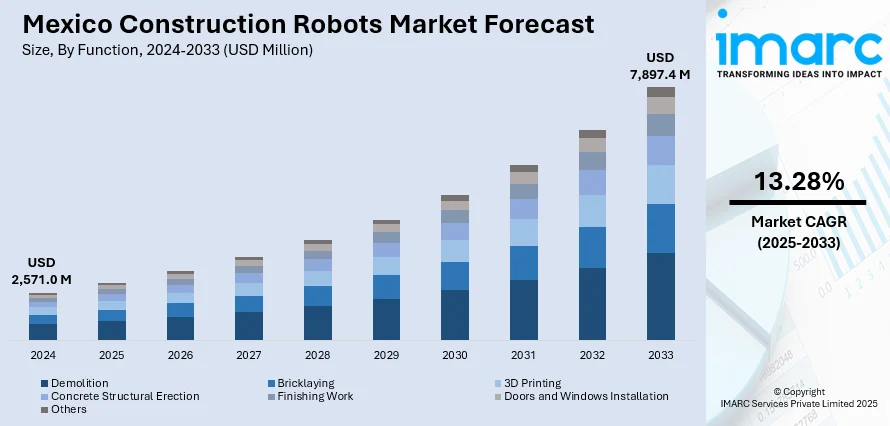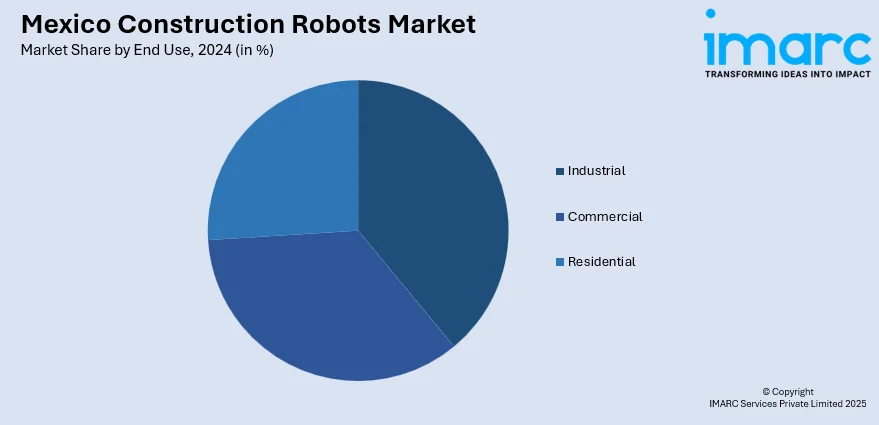
Mexico Construction Robots Market Size, Share, Trends and Forecast by Function, Type, End Use, and Region, 2025-2033
Mexico Construction Robots Market Overview:
The Mexico construction robots market size reached USD 2,571.0 Million in 2024. Looking forward, IMARC Group expects the market to reach USD 7,897.4 Million by 2033, exhibiting a growth rate (CAGR) of 13.28% during 2025-2033. The market is propelled by labor shortages and rising labor costs, prompting firms to adopt automation for efficiency. Advancements in robotics technology enhance operational precision and safety, while the demand for scalable solutions supports large-scale infrastructure projects.
|
Report Attribute
|
Key Statistics
|
|---|---|
|
Base Year
|
2024
|
|
Forecast Years
|
2025-2033
|
|
Historical Years
|
2019-2024
|
| Market Size in 2024 | USD 2,571.0 Million |
| Market Forecast in 2033 | USD 7,897.4 Million |
| Market Growth Rate 2025-2033 | 13.28% |
Mexico Construction Robots Market Trends:
Labor Shortages and Rising Labor Costs
Mexico's construction sector is experiencing growing labor shortages due to a shrinking skilled workforce and rising labor costs. The current industry challenges motivate building companies to implement new productivity enhancements that minimize their dependence on the human workforce. Construction robots create cost-efficient outcomes by executing repetitive jobs and dangerous and physically intense jobs with higher efficiency. Robots run operating schedules without breaks, which shortens construction duration for projects. As demand for infrastructure grows, especially in urban areas, automation becomes essential to meet deadlines and budget constraints, which is further fueling the Mexico construction robots market share. By addressing labor-related issues, construction robots are gaining traction as a strategic investment to maintain competitiveness and ensure consistent project execution across Mexico’s expanding construction industry.

Demand for Improved Safety and Operational Efficiency
Safety remains a top priority on construction sites, particularly in high-risk environments. In Mexico, where construction often involves physically demanding or hazardous tasks, robots offer a safer alternative. Automation reduces the need for workers in risky areas, thereby lowering the chances of workplace injuries and accidents. In addition to improving safety, robots increase operational efficiency by maintaining consistent performance without fatigue or human error. Tasks such as bricklaying, demolition, and concrete printing are executed faster and with higher precision, which is creating a positive impact on the Mexico construction robots market outlook. These improvements help contractors meet tight deadlines, enhance quality control, and comply with safety regulations—making robots an asset for modern construction operations.
Growth in Infrastructure Development and Government Support
Mexico is witnessing significant infrastructure growth driven by urban expansion, industrialization, and government-backed development projects. For instance, in March 2025, the Mexican government, through the National Water Commission (Conagua), revealed a historic investment of 122.6 billion pesos (MDP) - more than 5.6 billion euros - for 2025-2030 as part of the National Water Plan. This investment is intended for 17 strategic water infrastructure projects in the areas with the highest water demand and flood risk. These initiatives demand faster, safer, and more cost-efficient construction methods, thereby driving the Mexico construction robots market growth. Construction robots can help meet these needs by reducing manual labor, increasing precision, and speeding up the building process. Moreover, government interest in modernizing construction practices and improving workplace safety aligns with the broader adoption of robotics. Public-private partnerships and international investments further encourage the use of smart construction technologies. As the nation continues to invest in roads, bridges, and housing, robots are becoming essential to scale operations and maintain quality standards across projects.
Mexico Construction Robots Market Segmentation:
IMARC Group provides an analysis of the key trends in each segment of the market, along with forecasts at the regional level for 2025-2033. Our report has categorized the market based on function, type, and end use.
Function Insights:
- Demolition
- Bricklaying
- 3D Printing
- Concrete Structural Erection
- Finishing Work
- Doors and Windows Installation
- Others
The report has provided a detailed breakup and analysis of the market based on the function. This includes demolition, bricklaying, 3D printing, concrete structural erection, finishing work, doors and windows installation, and others.
Type Insights:
- Traditional Robot
- Robotic Arm
- Exoskeleton
A detailed breakup and analysis of the market based on the type have also been provided in the report. This includes traditional robot, robotic arm, and exoskeleton.
End Use Insights:

- Industrial
- Commercial
- Residential
A detailed breakup and analysis of the market based on the end use have also been provided in the report. This includes industrial, commercial, and residential.
Regional Insights:
- Northern Mexico
- Central Mexico
- Southern Mexico
- Others
The report has also provided a comprehensive analysis of all the major regional markets, which include Northern Mexico, Central Mexico, Southern Mexico, and others.
Competitive Landscape:
The market research report has also provided a comprehensive analysis of the competitive landscape. Competitive analysis such as market structure, key player positioning, top winning strategies, competitive dashboard, and company evaluation quadrant has been covered in the report. Also, detailed profiles of all major companies have been provided.
Mexico Construction Robots Market Report Coverage:
| Report Features | Details |
|---|---|
| Base Year of the Analysis | 2024 |
| Historical Period | 2019-2024 |
| Forecast Period | 2025-2033 |
| Units | Million USD |
| Scope of the Report | Exploration of Historical Trends and Market Outlook, Industry Catalysts and Challenges, Segment-Wise Historical and Future Market Assessment:
|
| Functions Covered | Demolition, Bricklaying, 3D Printing, Concrete Structural Erection, Finishing Work, Doors and Windows Installation, Others |
| Types Covered | Traditional Robot, Robotic Arm, Exoskeleton |
| End Uses Covered | Industrial, Residential, Commercial |
| Regions Covered | Northern Mexico, Central Mexico, Southern Mexico, Others |
| Customization Scope | 10% Free Customization |
| Post-Sale Analyst Support | 10-12 Weeks |
| Delivery Format | PDF and Excel through Email (We can also provide the editable version of the report in PPT/Word format on special request) |
Key Questions Answered in This Report:
- How has the Mexico construction robots market performed so far and how will it perform in the coming years?
- What is the breakup of the Mexico construction robots market on the basis of function?
- What is the breakup of the Mexico construction robots market on the basis of type?
- What is the breakup of the Mexico construction robots market on the basis of end use?
- What is the breakup of the Mexico construction robots market on the basis of region?
- What are the various stages in the value chain of the Mexico construction robots market?
- What are the key driving factors and challenges in the Mexico construction robots market?
- What is the structure of the Mexico construction robots market and who are the key players?
- What is the degree of competition in the Mexico construction robots market?
Key Benefits for Stakeholders:
- IMARC’s industry report offers a comprehensive quantitative analysis of various market segments, historical and current market trends, market forecasts, and dynamics of the Mexico construction robots market from 2019-2033.
- The research report provides the latest information on the market drivers, challenges, and opportunities in the Mexico construction robots market.
- Porter's five forces analysis assist stakeholders in assessing the impact of new entrants, competitive rivalry, supplier power, buyer power, and the threat of substitution. It helps stakeholders to analyze the level of competition within the Mexico construction robots industry and its attractiveness.
- Competitive landscape allows stakeholders to understand their competitive environment and provides an insight into the current positions of key players in the market.
Need more help?
- Speak to our experienced analysts for insights on the current market scenarios.
- Include additional segments and countries to customize the report as per your requirement.
- Gain an unparalleled competitive advantage in your domain by understanding how to utilize the report and positively impacting your operations and revenue.
- For further assistance, please connect with our analysts.
 Request Customization
Request Customization
 Speak to an Analyst
Speak to an Analyst
 Request Brochure
Request Brochure
 Inquire Before Buying
Inquire Before Buying




.webp)




.webp)












